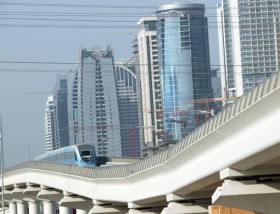By Ashfaq Ahmed, Chief Reporter, www.gulfnews.com
In exactly 100 days, Dubai will make history by opening the first Metro system in the region. The world’s largest automated driverless Metro system is being built by 30,000 workers at an unprecedented pace and will serve around 1.2 million passengers every day. Amid the final phase of construction, Gulf News brings you the countdown each day leading up to the opening of the Red Line on 09-09-09.

Dubai: The Dubai Metro will open its doors to commuters on schedule with the launch of the Red Line on September 9.Work on the Dh15.5-billion Dubai Metro project – the world’s largest automated driverless Metro system – is now into the 46th month of a scheduled 49-month project delivery period. The project took off in October 2005 and has not been thrown off course even by the economic downturn.
More than 30,000 workers including engineers, consultants, contractors and technicians are working over three shifts to complete the project on schedule.
The total length of the project is 76km including the 52.1-km Red Line and 23.9-km Green Line, which is scheduled to open on March 21, 2010.
Some 3,200 people are being trained to ensure the smooth operation of the Metro. UK-based company Serco has been tasked with operating the Metro for the first 10 years. Serco is currently providing training to employees – including UAE nationals – as it gears up for the launch of the Red Line.
“The Metro is expected to change life in Dubai as it will not only provide easy public transport but will also help reduce traffic, improve environment and attract tourists,” said Abdul Majeed Al Khaja, chief executive officer of the Rail Agency of the Dubai Roads and Transport Authority (RTA), which is carrying out the project.
Dubai Metro will be the fundamental solution to ensure smooth traffic flow, Dubai loses roughly around Dh5 billion every year due to traffic congestion.
Construction of the Metro project is progressing as scheduled with more than 93 per cent of the work completed on the Red Line and more than 60 per cent completed on the Green Line.
The Red Line, which runs from Rashidiya to Jebel Ali along Shaikh Zayed Road links major business centres, shopping malls and Dubai Airport’s Terminals 1 and 3. There will be 29 stations along the line including four underground. The Red Line will have a capacity of 23,000 passengers per hour in each direction and will traverse a distance of 4.7km underground and 47.4km of elevated track.
The elevated track, called the viaduct, has been completed. The rail track on the Red Line has also been laid and is being used for test runs.
The longest train run was successfully conducted from Jebel Ali to Emirates airline station covering approximately 49 out of 53km on the Red Line at a speed of 90km/h.
The critical tunnelling work on both the Red and Green lines was completed in December 2008 and the tailormade tunnel boring machines called Wugiesha have been dismantled.
Out of the total 76km, some 12.6km of the Metro will run underground, mainly in the Central Business District of Deira and Bur Dubai.
Out of a total of 79 trains, more than 44 locomotives have been delivered from Japan. The Red Line will have a maximum of 62 trains and the Green Line will have 17 trains.
Routine dynamic tests are being conducted on the trains as they undergo tests on the test track stretching from the Jebel Ali Industrial station to the Jumeirah Lake Towers station.
Construction is also progressing rapidly on all 47 Metro stations. Passengers will be able to travel in comfort even during the harsh summer months with the stations, pedestrian bridges, buses and bus stops serving the Metro offering air-conditioned exits.
Residents of areas not served by the Metro will have easy access to other modes of transport to reach stations as the RTA has prepared a comprehensive integrated public transport system that will rely on public buses, water buses, taxis and private vehicles.
The RTA is planning to widen its bus network and its fleet of buses and taxis. Around 700 dedicated buses will provide a feeder service for communities living in the vicinity of the Metro stations. The feeder service has been planned in such a way that no passenger will have to walk more than 100 metres from his or her place of residence to get a bus or reach a Metro station.
The RTA has also built huge parking complexes at the three major Metro stations. A parking lot has been built at the Rashidiya station on the Red Line for 2,700 cars and another parking lot that can accommodate 2,000 cars is being built at the Jumeirah Islands Station that serves the same line.
A parking complex with a capacity of about 3,000 cars is also being built at the Qusais station on the Green Line. Al Qusais and Rashidiya parking lots will serve commuters from Sharjah, Ajman and other northern emirates, who want to use the ‘park and ride’ facility. Parking will be free for Metro users.
Fares for the Dubai Metro are yet to be announced but Al Khaja recently said that the fares would be affordable for all segments of passengers because the RTA wants the maximum number of people to use the Metro.
















